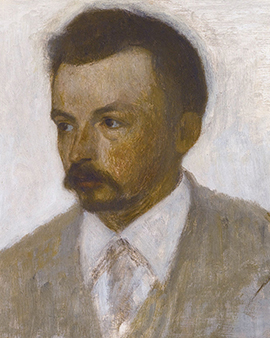The Danish painter Vilhelm Hammershoi found his favorite motifs in the rooms of his respective current apartment: open double doors or windows, sunlight falling into the sparsely furnished rooms, cast shadows on the wall, or even his wife absorbed in a domestic activity. His sister or his mother with her characteristic hood also appear again and again in his paintings. Looking at his works through the years, one can watch the wife Frederikke aging.
Vilhelm Hammershoi came from an upper middle-class family, but he did not want to become a merchant like his father. Born in Copenhagen in 1864, he received drawing lessons as a child and later studied at the Royal Danish Academy of Art. The Copenhagen art scene had little use for his melancholy, quiet interiors and genre scenes, and his first paintings were rejected. With a comrade-in-arms, he therefore created his own exhibition opportunities and founded "Den Frie Udstilling" - "The Free Exhibition", a kind of Danish secession. As early as 1889, he participated in the Great World Exhibition in Paris with a few works for Denmark. His interiors seem to be influenced by the French Nabis, and it is precisely during their first years that he stays in the French capital. However, the bright colors that the Nabis like to use for their paintings are not his thing. He loves the melancholy of muted colorfulness, but time and again he also sets color or light accents. For example, when a ray of sunlight falls on the window frame in a dark backyard. A sign of hope? The Nordic temperament? In some of his paintings, one is reminded of works by Edward Hopper. But if the latter is much more firmly rooted in the modern world of the 20th century, Hammershoi's works seem to have fallen out of time, strangely still. It is not without reason that he is called the "Danish Vermeer" today. His paintings retain their mystery. They seem symbolically charged without being obtrusive.
Vilhelm Hammershoi particularly reveres the work of the great American James McNeill Whistler. During a stay of several months in London, he wants to meet him, but does not succeed. So Hammershoi continues to work as if in secret and gradually his work becomes known. Even the great impresario Sergei Djagilev, founder of the groundbreaking "Ballets Russes", acquired two paintings by him. The Berlin gallery owner and art dealer Paul Cassirer also exhibited him in his Hamburg rooms. A highly respected council member of the Copenhagen Academy of Art, Hammershoi spent his last years mostly painting within his familiar four walls. Only rarely did he paint melancholy, deserted city or harbor scenes in Copenhagen, London, or Rome, but he did not become known for these. After his death in 1916 from cancer, his work initially fell into oblivion outside Denmark for many decades. It was not until the 1990s that his uniquely atmospheric paintings were rediscovered. Vilhelm Hammershoi is today considered one of the most important representatives of Symbolism.
×





.jpg)
.jpg)
.jpg)
.jpg)
.jpg)
.jpg)
.jpg)
.jpg)
.jpg)
.jpg)
.jpg)
.jpg)
.jpg)
.jpg)
_-_(MeisterDrucke-953321).jpg)
_-_(MeisterDrucke-953321).jpg)
.jpg)
.jpg)
.jpg)
.jpg)
_-_(MeisterDrucke-953315).jpg)
_-_(MeisterDrucke-953315).jpg)
_1884_(oil_on_canvas_laid_down_o_-_(MeisterDrucke-160472).jpg)
_1884_(oil_on_canvas_laid_down_o_-_(MeisterDrucke-160472).jpg)
.jpg)
.jpg)
.jpg)
.jpg)
.jpg)
.jpg)
.jpg)
.jpg)
.jpg)
.jpg)
.jpg)
.jpg)
.jpg)
.jpg)
.jpg)
.jpg)
.jpg)
.jpg)
.jpg)
.jpg)
.jpg)
.jpg)
.jpg)
.jpg)
.jpg)
.jpg)
.jpg)
.jpg)
.jpg)
.jpg)
.jpg)
.jpg)
.jpg)
.jpg)
.jpg)
.jpg)
.jpg)
.jpg)
.jpg)
.jpg)
.jpg)
.jpg)
.jpg)
.jpg)
.jpg)
.jpg)
.jpg)
.jpg)
.jpg)
.jpg)
.jpg)
.jpg)
.jpg)
.jpg)
.jpg)
.jpg)
.jpg)
.jpg)
.jpg)
.jpg)
.jpg)
.jpg)
_-_(MeisterDrucke-139134).jpg)
_-_(MeisterDrucke-139134).jpg)
.jpg)
.jpg)
.jpg)
.jpg)
.jpg)
.jpg)
_-_(MeisterDrucke-1034453).jpg)
_-_(MeisterDrucke-1034453).jpg)
.jpg)
.jpg)
_Oil_on_canvas_-_(MeisterDrucke-995008).jpg)
_Oil_on_canvas_-_(MeisterDrucke-995008).jpg)
.jpg)
.jpg)
.jpg)
.jpg)
.jpg)
.jpg)
.jpg)
.jpg)
.jpg)
.jpg)
.jpg)
.jpg)
.jpg)
.jpg)
.jpg)
.jpg)
.jpg)
.jpg)
.jpg)
.jpg)
.jpg)
.jpg)
.jpg)
.jpg)
.jpg)
.jpg)
_c_1897_(oil_on_canvas)_-_(MeisterDrucke-1633084).jpg)
_c_1897_(oil_on_canvas)_-_(MeisterDrucke-1633084).jpg)
.jpg)
.jpg)
.jpg)
.jpg)
.jpg)
.jpg)
.jpg)
.jpg)
.jpg)
.jpg)
.jpg)
.jpg)
.jpg)
.jpg)
.jpg)
.jpg)
.jpg)
.jpg)
.jpg)
.jpg)
_-_(MeisterDrucke-907181).jpg)
_-_(MeisterDrucke-907181).jpg)
.jpg)
.jpg)
.jpg)
.jpg)
.jpg)
.jpg)
.jpg)
.jpg)
.jpg)
.jpg)
.jpg)
.jpg)
.jpg)
.jpg)
.jpg)
.jpg)
.jpg)
.jpg)
.jpg)
.jpg)
.jpg)
.jpg)
.jpg)
.jpg)
.jpg)
.jpg)
.jpg)
.jpg)
.jpg)
.jpg)
.jpg)
.jpg)
.jpg)
.jpg)
.jpg)
.jpg)
.jpg)
.jpg)
.jpg)
.jpg)
_detail_-_(MeisterDrucke-953332).jpg)
_detail_-_(MeisterDrucke-953332).jpg)
.jpg)
.jpg)
.jpg)
.jpg)
.jpg)
.jpg)
.jpg)
.jpg)






